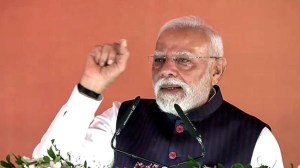When greed takes its toll on nature
Although the controversy over pesticide residues in bottled water erupted soon after the Mahatma Gandhi’s death anniversary, few commen...

Although the controversy over pesticide residues in bottled water erupted soon after the Mahatma Gandhi’s death anniversary, few commentators recalled his warning against India following the pattern of urbanising and profit-driven industrialism.
Nature, said Gandhi, provides enough for man’s need but not for his greed. A half century after his death, his words ring true: our rivers stand polluted and forests depleted, thanks to ruthless commercial exploitation. Not only has the Ganga, whose water used to be synonymous with purity, become unfit even for bathing, groundwater has, in many places, become contaminated because of reckless use of insecticides in pursuit of higher agricultural productivity and profit.
In 1910, Gandhi issued his first manifesto on the importance of human ecology in the form of a pamphlet entitled Hind Swaraj. This was 63 years before E.F. Schumacher’s celebrated work Small is Beautiful. From the ideas outlined in Hind Swaraj grew his programmes for Khadi and village industries, designed to make local communities rely on their own resources and labour as far as possible.
Prominent among those who dedicated their energies to Gandhi’s constructive programme was C. Rajagoplachari, a leading lawyer of Salem who threw away a lucrative practice and established an ashram where so-called untouchables lived and worked alongside others. So it seemed entirely natural for Gandhi to proclaim, as he did in the 1920s, that Rajaji was his only possible successor.
Gandhi’s approach did not appeal to Jawaharlal Nehru, a briefless lawyer whose father’s princely income from the bar made it unnecessary for him to earn a living. Nehru returned from a European tour in 1926-27, which included a visit to Stalin’s Russia, as a Marxist. With facile optimism, he believed that a change in the system would end both poverty and untouchability and that no reform work needed to be undertaken in the meantime.
By 1942, however, Gandhi changed his mind and named Nehru his successor. Why? Khasa Subba Rau, freedom fighter and editor of the Madras weekly Swatantra, speculated in 1957 that ‘‘perhaps he (Gandhi) felt that the Sardar might not be as acceptable to Muslims as the greatly Muslimised Prime Minister. Or it might be that he thought Rajaji too loftily ascetic an intellectual to be sentimentally pleasing to the circus-loving temperament of the masses.’’ An additional reason undoubtedly was that Nehru had decided in 1928, when he hastily withdrew from the brink of a revolt on the issue of Khadi, that he could retain and improve his position under the wing of, and not in opposition to, Gandhi.
In the last volume of his collected works, Gandhi had asserted that future governments would, after stumbling in attempts to imitate and compete with America or Soviet Russia, realise the truth that India had no option ‘‘except to develop village industries’’.
Nehru too disliked commercial advertising, and spoke of the advertiser as ‘‘one of the symbols of our age with his continuous and raucous attempts to delude us and induce us to buy unnecessary and even harmful products’’. In contrast, Indira Gandhi, as Prime Minister, introduced commercials in programmes aired on All India Radio in 1967, and on Doordarshan in 1976. Over the years since then, TV channels have proliferated and, with them, the advertising of factory-made, packaged, branded and marketed consumer goods including drinking water.
Gandhi, in deploring the effect of the machine on household and cottage industry, made no distinction between Indian-owned and foreign companies. They were equally inimical to self-employment at home, he said.
Similarly there is no difference between the bottled water produced and marketed by Indian as well as foreign companies. Both have been found to be contaminated — whether it is Bisleri, an Indian brand which is the market leader, or Kinley, manufactured by Coca Cola. The only brand which was found clean among the samples tested by the Centre for Science and Environment, Delhi, was Evian, packaged in France and sold for Rs 90 a litre here.
The question is whether it is possible to cry a halt to, and reverse, the process of heedless industrialism. Can we strive to build an alternative to what Gandhi condemned, in these strong words in the Young India issue of March 17, 1927: ‘‘I wholeheartedly detest this mad desire to destroy distance and time, to increase animal appetites and go to the ends of the earth in search of their satisfaction. If modern civilisation stands for all this, and I have understood it to do so, I call it Satanic.’’
Remedial action is not impossible. An example of the application of the Gandhian approach are the ‘‘bamboo tubewells’’ developed by Nanaji Deshmukh. Working from his headquarters at Chitrakoot in Madhya Pradesh, Nanaji has succeeded in having thousands of them put to work in several states in the neighbourhood of rivers, where no rocks need to be drilled. This has obviated the need for expensive cement-concrete tubes.
When I first met Nanaji some years ago in Delhi, I noticed, with surprise, a large statue of Gandhi, brightly lit, in an alcove by his side. The RSS patriarch said to me: ‘‘He showed us the destination. It is for us to find the path to reach there.’’
Other encouraging signs are the efforts to find sugarcane-based and other fuels to supplement petrol, and to develop non-conventional sources of energy such as solar panels and windmills. Here, cost comparison on conventional lines is irrelevant. The value of national self-reliance and the safeguarding of human ecology cannot be quantified in financial terms.





- 01
- 02
- 03
- 04
- 05


























